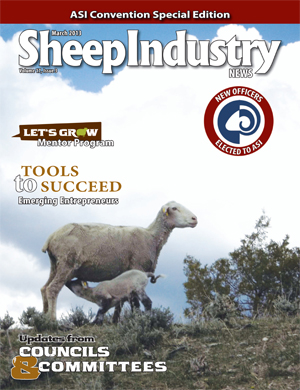
- March 2013
- Conaway Expresses Optimism on Farm Bill
- New Executive Board Members Elected to ASI
- President’s Notes
- ASI Elects New Officers
- I am Here to Work for You
- One Skin Type Can Not Make All Things
- Working to Reauthorize Livestock Mandatory Reporting
- Lamb Industry Assessment: Roadmap for the Industry
- Guns, Immigration, Fiscal Policies and Legacy Issues
- Re-Build Committee to Offer Funds for Mentor Program
- Bighorn Sheep and Disease Issues Cover at PERC Meeting
Working to Reauthorize Livestock Mandatory Reporting
By AMY TRINIDAD
Sheep Industry News Editor
(March 1, 2013) With the Livestock Mandatory Reporting (LMR) Act expiring in 2015, ASI has been working with the U.S. Department of Agriculture’s Agricultural Marketing Service (AMS) to ensure and provide for more accurate and usable market information. One of the major benefits of LMR is that through information transparency it encourages competition in the marketplace; however, due to industry consolidation, an increasing amount of lamb market data cannot be report by AMS and/or is at risk of not being reported because data does not meet LMR rules and regulations, according to Erica Rosa-Sanko, an agricultural economist representing the Livestock Marketing Information Center. Rosa-Sanko addressed the Lamb Council and the American Sheep Industry Association Board of Directors at the annual convention in San Antonio.
According to Rosa-Sanko, two major LMR regulatory issues impact lamb price reporting:
- the guidelines determining who is and who is not eligible to report under LMR; and
- confidentiality regulations pertaining to how those parties’ data are reported.
Under LMR regulations, those who are required to report under LMR include a lamb packer who’s federally inspected plant processes an average of at least 75,000 lambs each year for the prior five calendar years and a lamb importer with an average of 2,500 metric tons of lamb meat products per year during the preceding five calendar years. In addition, in order to protect the identity of reporting entities and preserve transaction confidentiality, the 3/70/20 rule applies.
The 3/70/20 rule requires:
- At least three reporting entities need to provide data at least 50 percent of the time over the most recent 60-day period.
- No single reporting entity may provide more than 70 percent of the data for a report over the most recent 60-day period.
- No single reporting entity may be the sole reporting entity for an individual report more than 20 percent of the time over the most recent 60-day time period.
However, due to a smaller, highly concentrated industry with an increase in the number of smaller commercial packing entities, the industry no longer easily fits within the established regulatory guidelines of LMR says Rosa-Sanko.
“The result is that the amount of market information and data under LMR continues to declines,” says Rosa-Sanko. “These changes that have occurred in the industry are expected to continue and will impact what types of market data can be reported and be pertinent to the industry.”
A number of recommendations have been developed by LMIC; however, five high priority items have been identified:
- Adjust packer processing thesholds downward from 75,000 lambs to a range of 35,000 to 55,000 lambs each year.
- Adjust importer volume thresholds downward from 2,500 metric tons of lamb to 1,500 metric tons of lambs each year.
- Adjust current LMR regulations for processing entities and importers from a prior five calendar years to two to three calendar years.
- Combine the two countries (Australia and New Zealand) into a regional category called Oceana, combine fresh and frozen product and reduce the amount of detail in the number of product item categories reported in the National Weekly Lamb Carcass and Lamb Cuts – Imported Product report.
- Adjust pelt price reporting to that of an estimated “value paid for all pelts by packers on slaughter lambs purchased on a negotiated, formula or contract basis” which includes an average low/high pelt value range.
“It is imported to continue discussions with AMS about what changes to current lamb LMR reporting forms are needed starting now,” she concludes.

